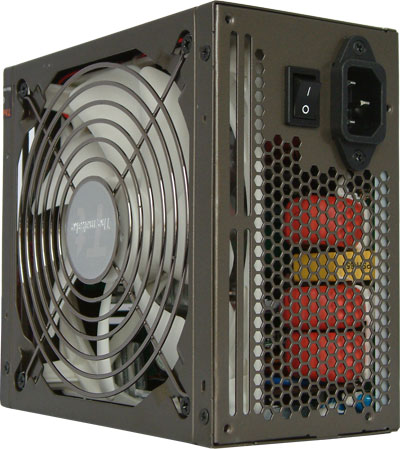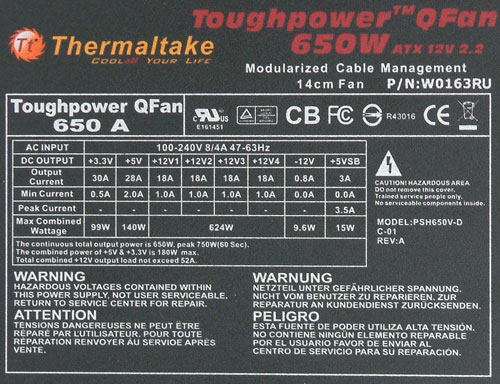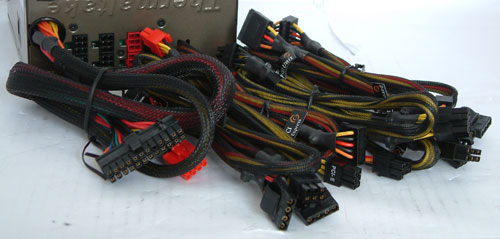Power Supply Roundup: 650W-680W
by Christoph Katzer on February 21, 2008 2:00 AM EST- Posted in
- Cases/Cooling/PSUs
Thermaltake Toughpower QFan 650W

Thermaltake enters the fray with a new feature called QFan. This means the frame is practically left open and the power supply casing has also long punched holes on the sides around the fan. This allows the fan to suck in additional air and - according to Thermaltake - it reduces turbulence and noise. The housing comes in a brown-grayish color that fits nicely with the red Thermaltake highlights we often see on their cases. The packaging is durable and keeps the power supply protected during transport.

The label looks pretty much like all the others: four separated 12V rails at 18A and a combined power of 624W. The combined power for the lower voltage rails isn't mentioned; only their highest output is written on the label. We'd like to have specific details from Thermaltake, but it's not too much of a stretch to assume that the combined power is going to be similar to the 170W we see on all the other units today.

The cables are stored in a quality bag, which is a nice addition. All cables are sleeved up to the first connector. The chassis connection jacks are 6-pin designs, which have proven to be very stable. There are sufficient cables and connectors to provide power to most midrange to moderate high-end systems.

The inside looks an awful lot like two other power supplies we're reviewing today, and in fact we have seen this design a lot lately. It seems that 40% of the high-end market comes via CWT (Channel Well Technology) these days. Thermaltake was actually one of the first with this design, and many others followed. That said, being manufactured by the same company doesn't mean these power supplies are all the same. There are still many differences in terms of component choice and heatsink designs, and this will be reflected in our graphs later - the differences are quite noticeable. What we never liked with this particular design is the heatsinks - they simply don't make much sense. They are made of an aluminum plate punched into the right shape, which is not unusual, as it's an inexpensive way to make a heatsink. The problem with Thermaltake's approach is that there are no gaps to pass air through, so the heatsinks function like an umbrella not letting any air go through to the components under the heatsink. Seasonic is also making their heatsinks in the same way but they at least have enough space in between the fins for the air to pass by. The chosen components are mostly high quality such as the Hitachi capacitor sitting on the primary side and the secondary side is equipped with Samxon capacitors, but the heatsinks are still far bulkier than necessary.










23 Comments
View All Comments
larson0699 - Monday, August 4, 2008 - link
You mentioned that the label on the Thermaltake unit doesn't state maximum combined load of the lower-volt rails.But look, it does. 180 Watts.
BRDiger - Tuesday, July 29, 2008 - link
I kind a wondering because comparing the efficiency level of the Be Quiet! to the testing datasheet on the 80plus.org site it just reaches about 80% at 100% load unlike your results with nearly 84%. Comparing it to the Enermax Modu 82+ review here, it even exeeds its efficiencyJust wondering and it´s not supposed to be an offence...
BRDiger - Tuesday, July 29, 2008 - link
Well, after reading another review it seems that 80plus was actually wrong and the be quiet!s performance exeeds the enermax..strikeback03 - Friday, February 22, 2008 - link
Thermal and fluids was not my best subject in school, but don't fans usually lose air off the tips of the blades, not suck it in? That is my experience with the Zerotherm Nirvana, which seems to make the same claim of sucking air in with its open fan.mo3 - Friday, February 22, 2008 - link
The new Enermax Modular 82+ & Pro 82+ can peak over 700Watts with out a problem; also they have the ATX12v V2.3 and reaching 88% efficiency.Modular 82+ has 2x 12 pin connection embedded for up and coming graphics cards and greater stability.
Just to give the readers a better alternative! :)
Check out more info at: www.enermax.co.uk
crimson117 - Friday, February 22, 2008 - link
Okay... PSU review.. new 9600 GT review... I think anandtech is trying to tell me I need a new computer!NINaudio - Thursday, February 21, 2008 - link
Hi, you mention that the be quiet! PSU is quiet but also runs warmer than the others. Where are the temperature charts that we've seen in previous PSU reviews? It would be good to see the temperatures that you sacrifice for a quieter PSU. Is it a degree, 5 degrees, ten degrees, more?tynopik - Thursday, February 21, 2008 - link
1. include a real stress test like how the units handle rapidly changing input voltagesay load them up to 80% capacity and then connect them to a variac and dip the voltage to ~90V 3 times in quick succession to simulate a brownout or poor electrical conditions and check that
a) it doesn't blow up
b) it maintains quality output while the input if fluctuating
2. include cheapo units for comparision just for the reminder of what a poor quality unit is
3. i really love your connector length charts, far more useful than the usual 'stetch a jumble of cables out and lay a ruler next to it' approach. i just wish you would do the same for the sata/peripheral connectors
4. i'm really like the way you combined all the acoustic and efficiency charts together instead of having a bunch of individual charts
Christoph Katzer - Thursday, February 21, 2008 - link
I just assembled a nice system do to those tests. Once it's up and running I will include it. Will also make a comparison of all cables from now on, thanks.The problem with cheap units is that they are mostly for a specific market. I would need to buy thise units myself since no company would ever send them over. Since I am not in the US I will only have the stuff from Europe which is not even available in the US. But let us see how we could change that in the future...
jtleon - Thursday, February 21, 2008 - link
Chris,You state that at least 100W must be drawn before these units achieve high efficiency. Can you relate this requirement to most normal PC tasks - i.e. browsing the web (reading Anandtech reports of course), answering email, other office based activities (the majority of PC users on the planet), rather than those hardcore gamers that are gaming around the clock (and clearly are independently wealthy!).
It would appear that these PSU's are not going to efficiently reduce the carbon footprint of the majority of PC users on this planet.
Am I wrong?
Regards,
jtleon